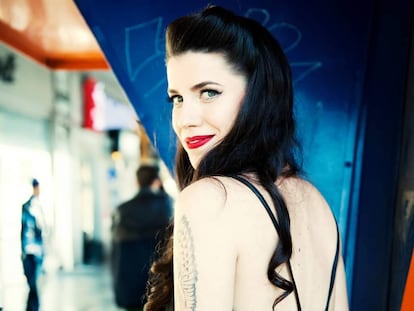The film of the Hamas attack on the Nova festival is hard to bear, and it’s all real
The documentary ‘We Will Dance Again’ reconstructs the six hours of terror on October 7, 2023 by linking together recordings made by the victims and the attackers
In the first few minutes of We Will Dance Again, if we didn’t know what was going to happen, we could enjoy the enthusiasm of all those young people partying, some 3,500 of them, at the Tribe of Nova festival, or Supernova, which everyone just calls Nova. The location was announced at the last minute: a set of tents, booths, and stages in an open field in southern Israel, just five kilometers (3.1 miles) from the border with Gaza. It was a summery day in the middle of October, which is typical in the area, and these youngsters had eschewed Friday dinner with their families — a serious matter in Jewish society — to get to the electronic music festival and be in the mood before dawn, which is when the partying really gets going.
Many of those in attendance admit to being high on ecstasy or acid, quite a few of them belong to the LGBTQ+ community, and a father holds his teenage daughter, who is wheelchair-bound, in his arms so that she can join in the dancing. The festive narrative suddenly turns into a horror film: at 6:30 a.m. revelers witness an exchange of missiles in the sky. The DJ immediately cuts off the sound and says: “Red alert.” Israelis in border areas take it as a matter of course that such things happen (the Iron Dome usually repels the projectiles), so some hurry to leave, but others decide to wait to avoid the traffic jam. Those that remained will be surprised by armed men dressed in black, members of Hamas. It was the massacre of October 7, 2023: 364 festival-goers were killed, more than 10% of the attendees, and 44 were kidnapped. Across the area, the terrorist attack that day caused 1,200 deaths and 250 people were taken hostage.
We Will Dance Again is an urgent, chilling and very well-produced documentary that was released in August in the U.S. and has just been made available on the Movistar+ platform in Spain to mark the first anniversary of the tragedy. Directed by Israeli filmmaker Yariv Mozer, it is a minute-by-minute, meticulous reconstruction of what happened that day, narrated in an hour and a half like a film, with the difference that everything is real. The footage weaves together recordings, most of them from cell phones, taken by festival attendees, the security cameras at the venue, and by the Hamas militiamen who wore devices on their foreheads to film their attack. The only respite comes from the interviews with survivors, who speak calmly and with anguish over their loved ones who were killed there, about how they miraculously survived among piles of corpses, and about how to start a new life while carrying the enormous weight of trauma.
It is not an easy experience to endure, nor is it advisable viewing for sensitive people, but as a historical and journalistic document it is very valuable. We have never before borne witness to a massacre like this. We become attached to the story of these young people, those who survived and those who did not. We see shots to the head at point-blank range, roads dotted with corpses, rows of stationary cars with no one alive inside, the escape of those who ran in the open and fell into a macabre game of life and death like Squid Game, grenades thrown against shelters. The terror of those who hid in toilets, trailers, or trash containers, and the desperate calls to a police force that seemed useless. The six hours it took the Israeli army to regain control of the area, taken by surprise by Hamas in an operation as audacious as it was ruthless, are endless.

The documentary is limited to what happened at the festival. It does not pretend to provide the keys to understanding a long-running regional conflict. We know what came after the atrocious Hamas attack: an escalation of brutality that continues to cause death and suffering in Gaza, the West Bank, and Lebanon. Only a few captions, at the beginning and end of the film, provide context. It says, from the beginning, that the Israeli response to the attack has resulted in the deaths of more than 40,000 people in Gaza; it also explains that groups of victims have sued the security forces for their obvious negligence. “The human cost of the Hamas massacre and the war that has followed in Gaza has been catastrophic for both Israelis and Palestinians,” a caption states.
In an interview with EL PAÍS, Mozer explained that some of the people invited to view the documentary before its premiere, who had witnessed the massacre, had to leave the room because they could not bear it. He says that he included graphic images, but left out the very graphic ones. And he makes his position clear, which is very critical of his government, in favor of a ceasefire that should have been reached “many months ago,” and of the two-state solution. “I want to think that, at some point, both in Palestine and in my country, the right people will come to power to put an end to all this,” he said.
Of course, this account is only part of the story, but it is all true. Of course, there are many other victims; those of the bombings, the incursions, hunger, the demolition of their homes, or forced displacement. It will fall to others to make a documentary about the umpteenth devastation of Gaza, and of course they will have to be Palestinian because Israel does not allow access to the Gaza Strip to the international media. Amid the horror of a war that is expanding, and to which there is no end in sight, the victims of October 7 deserve to be remembered. Those on the other side, who are more numerous, deserve to be remembered as well.
Sign up for our weekly newsletter to get more English-language news coverage from EL PAÍS USA Edition
Tu suscripción se está usando en otro dispositivo
¿Quieres añadir otro usuario a tu suscripción?
Si continúas leyendo en este dispositivo, no se podrá leer en el otro.
FlechaTu suscripción se está usando en otro dispositivo y solo puedes acceder a EL PAÍS desde un dispositivo a la vez.
Si quieres compartir tu cuenta, cambia tu suscripción a la modalidad Premium, así podrás añadir otro usuario. Cada uno accederá con su propia cuenta de email, lo que os permitirá personalizar vuestra experiencia en EL PAÍS.
¿Tienes una suscripción de empresa? Accede aquí para contratar más cuentas.
En el caso de no saber quién está usando tu cuenta, te recomendamos cambiar tu contraseña aquí.
Si decides continuar compartiendo tu cuenta, este mensaje se mostrará en tu dispositivo y en el de la otra persona que está usando tu cuenta de forma indefinida, afectando a tu experiencia de lectura. Puedes consultar aquí los términos y condiciones de la suscripción digital.
More information
Archived In
Últimas noticias
Welcome to the post-religion era: The idea of Christianity as the absolute truth has become obsolete
‘I thought you would like it’: The risky sexual practice popularized by TV shows and TikTok
The digitalization of tourism: ‘They promise experiences and gave us the worst possible one’
Mexican peso defies uncertainty with forecasts of a new period of stability in 2026
Most viewed
- Sinaloa Cartel war is taking its toll on Los Chapitos
- Reinhard Genzel, Nobel laureate in physics: ‘One-minute videos will never give you the truth’
- Oona Chaplin: ‘I told James Cameron that I was living in a treehouse and starting a permaculture project with a friend’
- Why the price of coffee has skyrocketed: from Brazilian plantations to specialty coffee houses
- Silver prices are going crazy: This is what’s fueling the rally












































